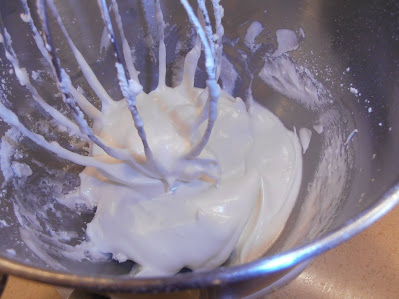I've been translating Encarnación Pinedo's 1898 cookbook, El cocinero español.
One category that caught my attention was called "Ante." Now that means "before", so I took it to mean it was an appetizer or a first course. But the recipes described a dessert, and that confused me. Seven of the eight recipes called for fruit cooked into a thick syrup and put into layers with an ingredient called "mamón". The eighth called for "bizcocho", which is a biscuit. I believed from this that mamón was bread or cake.
A look around the internet first seemed that my hunch was right. I found a recipe for a chiffon cake called mamon, but it was from the Philippines, and I wasn't sure it was the same thing. Digging some more, I found that mamón could refer to the Spanish lime, which is like a cross between a lychee and a lime. It is a fruit that people mostly eat fresh, although it is popular as a juice. Looking hard at the recipes, I tried to imagine a first course refreshing beverage made with slices of Spanish limes.
But that just didn't seem right. Miss Pinedo lived in Northern California, and Spanish limes don't grow there. They could have been shipped but the recipes just seem to point to a cake.
I set that question aside and continued to read. And, guess what? I found a whole section on mamones much later on in the book. Yes, I was right, they are cakes or rolls, sweetened and sometimes flavored with anise or sweet almonds. The word "mamón" means "sucker", because sometimes they are moistened with a sugar syrup which they "suck up" or absorb. Another name for the mamón is "marquesote", and you can click here to read more about it. (This site is in Spanish but Google will translate it into English.)
To make an ante I needed to first make a mamón, and that is what this post is about. Come back again for the next post, which will be about the ante.
Here is Miss Pinedo's recipe, as found on page 153 of her book.
Mamones de almidón.
Se baten veinte y cuatro huevos, separadas las claras de las yemas, hasta que se pongan duras.
Aparte se mezclan con las claras dos pozuelos de azúcar en polvo, y estando bien incorporada, se le añadirán las yemas, revolviendo todo cerca de la estufa, vaciando en el batido diez y ocho onzas de almidón de maíz: se seguirá batiendo con una mano mientras se le pone con la otra el almidón, para que no forme granos. Tan luego como todo esté incorporado, se vaciará prontamente en las cajas, que solo se llenarán hasta la mitad para ponerlas á cocer en un horno suave.
Starch Mamones
Twenty-four eggs are beaten, the whites separated from the yolks, until they get hard.
In addition, two cups of powdered sugar are mixed with the whites, and then the yolks are well incorporated, stirring everything near the stove, then empty into the batter eighteen ounces cornstarch: continue beating with one hand while putting the starch in with the other, so that it does not form lumps. As soon as everything is incorporated, it will be promptly emptied into the boxes, which will only be filled halfway; put them to cook in a soft oven.
My Notes
I didn't know this technique, so I looked around the internet. Click here to see the video that helped me understand what to do. I used the quantities in this video so I didn't have to use 24 eggs. Note that I used powdered sugar as Miss Pinedo specified.
Redaction
5 eggs, separated
300 grams cornstarch
180 grams powdered sugar
Preheat the oven to 300 degrees F.
Beat the egg whites until stiff.
Add the powdered sugar in batches and mix it well into the egg whites, using a low speed on the mixer and stopping the scrape the sides as needed.
Add the yolks, one at a time, incorporating each one well before adding the next.
Then add the cornstarch, a big spoonful at a time, incorporating it well before adding the next and stopping to scrape the sides as needed.
Once the batter is done, pour it into pans. I chose to use four tiny loaf pans because I thought that shape would be best for the ante. Each pan was ungreased and filled about halfway.
The pans went onto a bigger pan so they could all be handled at once.
They baked for 40 minutes, until a pick inserted into the middle came out clean.
I let them cool in their pans on a wire rack until I could easily hold them, then I slid a spatula around the sides. They all popped out easily. They finished cooling on the rack.
 |
| Egg whites plus powdered sugar |
 |
| And now with the yolks |
 |
| The batter has the cornstarch and the pans are half full. |
 |
| Fresh out of the oven! |
 |
| Final cooling |
 |
| A close up. |
The Verdict
I sliced one loaf into 1/2 inch wide pieces lengthwise. The texture was perfect: uniformly tiny holes, no part was too dry or too wet. The exterior was just a little darker than the interior -- not over- or undercooked.
I tasted one. As a cake, it left something to be desired. The mouthfeel was more pasty than I expected, and rather dry, and the flavor was almost not there. I suppose that was to be expected as it was just cornstarch, sugar, and eggs. I think my mouth was expecting a moist piece of cake and this wasn't it.
But I knew how it was to be handled for the ante, so I consider it a success. Tune in to the next post to see how the ante turned out.










